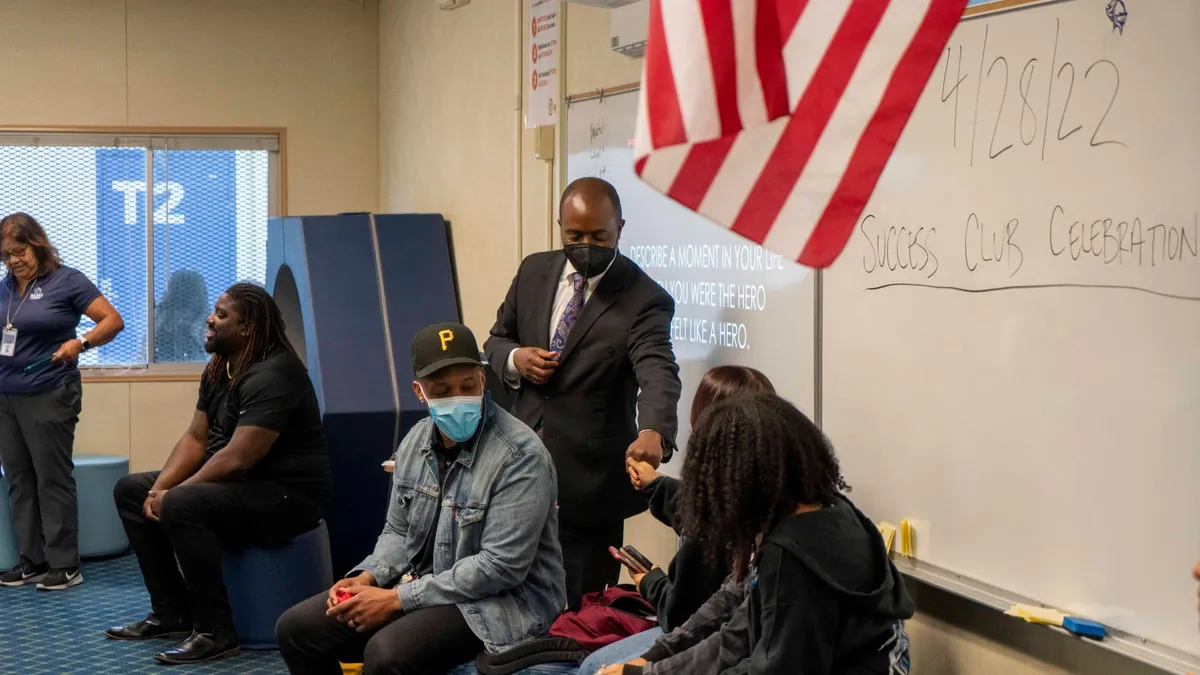LOS ANGELES — Mark Janus celebrated the one-year anniversary of his victory before the U.S. Supreme Court Thursday by joining educators and others working to inform public employees that they can opt out of their unions.
A year ago, the court ruled 5-4 in Janus v. American Federation of State, County, and Municipal Employees, Council 31 that requiring public employees to pay agency or “fair share” fees to a union they didn’t choose to join is a violation of the First Amendment.
Since then, Janus has left his job as a child support specialist for the Illinois Department of Healthcare and Family Services and is now a senior fellow with the Liberty Justice Center (LJC), a public interest law firm that helped to represent him in his case. He said he’s working to “give the individual the choice and the voice to make their own decision.”
Now that the constitutional question has been answered, the speakers noted that the next challenge is recovering those fees for employees that decided not to join or to opt out.
“Usually if you take someone’s property — even if it’s a mistake — you have to give it back,” said William Messenger, an attorney with the National Right to Work Legal Defense Foundation who argued the Janus case before the court. “Unions don’t believe that.”
If courts ultimately rule that unions should refund these fees, that could be a “second Janus moment,” said Patrick Hughes, president and co-founder of LJC.
Another outcome of the Janus decision could be an increase in local affiliates separating from their state and local unions, a trend that has already affected organizations like the Clark County Education Association in Nevada and the Memphis-Shelby County Education Association in Tennessee.
“Teachers are going to figure out, ‘We don’t need you,’” said Keith Williams, a former high school teacher in the Conewago Valley School District in Pennsylvania who won a case against his union when it charged non-union teachers a $435 fair-share fee. Now he runs Americans for Fair Treatment, a nonprofit. The National Education Association (NEA), however, is proposing steps that would make it harder for local unions to secede.
The event also included Rebecca Friedrichs, a former teacher in Orange County, California, whose case against the California Teachers Association over agency fees also made it to the Supreme Court. But Justice Antonin Scalia’s death in 2016 led to a 4-4 split in the case. She said she wants to “make it safe” for teachers to leave the union, and that there are those who “want to opt out and haven’t yet because they’re too scared.”
Non-union activists, however, are not the only ones spreading information about the Janus decision.
“I made sure all the members knew they could opt out because that’s their right,” said Davina Keiser, the chair of National Education Association’s (NEA) Republican Educators’ Caucus. Retired from the Long Beach Unified School District, Keiser now substitutes and is running for the school board. She said she remains a part of the union because she believes in some of the “values of union membership,” but has been “ostracized by other teachers” for her views.
Union membership growth
Meanwhile, teachers unions don’t appear to have been as wounded quite to the extent that some experts predicted. The NEA, with 3.2 million members, has gained more than 217,000 members — instead of losing an expected 200,000 — it announced in May and now “has more members today than it did last year before the court’s decision,” according to a press release.
Membership in the American Federation of Teachers (AFT) grew from almost 1,591,911 educators in 2017 to 1,677,775, according to U.S. Department of Labor data, and according to AFT, growth has continued this past school year as well.
Teachers unions did what they could to anticipate and offset the loss of agency fee payers. The Chicago Teachers Union (CTU), for example conducted an “aggressive” re-card campaign that “included extensive information-sharing on how the Janus case could set the stage to undermine our working conditions, our rights, our wages and benefits and our students’ needs, if the ruling was used successfully by its promoters to weaken our collective strength as union members,” according to a statement from Maria Moreno, CTU financial secretary. As a result, CTU membership has grown from 24,361 a year ago to 24,911 today.
Recent poll data, however, also shows many teachers are unaware of the effects of the Janus decision. Conducted by public opinion and data company YouGov, the survey of 1,003 U.S. teachers shows less than half of respondents — 48% — understand that the decision means teachers can’t be required to pay dues to a union. The survey was conducted for the Teacher Freedom Project, which is supported in part by the Association of American Educators (AAE) Foundation, a nonprofit affiliated with the non-union AAE.
The survey also shows more than three-fourths of respondents have not re-evaluated their union membership since the Janus decision. In addition, only 3% surveyed said they have joined a union since the decision, and only 1% answered that they’ve left a union since then.
‘All options on the table’
Teachers unions — from small charter affiliates to the 32,000-member United Teachers Los Angeles — have also completed another hectic year of walkouts, protests and strikes. And many of those actions have resulted in wage increases, as well as contract provisions related to class sizes and additional personnel.
Janus said he’s been somewhat surprised by the wave of teacher activism over the past year. “I didn’t think it was going to be the magnitude that it was,” he said.
Bradley Marianno, an assistant professor of educational policy and leadership at the University of Nevada, Las Vegas, said in an email that the strikes have been about more than contract negotiations.
“The strikes have helped [the unions] maintain momentum and showcase their utility as a voice for teachers,” he said. “Additionally, they’ve been able to use strike votes as formal membership campaigns to rally any teachers who were considering resigning or had previously resigned their membership.”
Talk of potential strikes this fall is also occurring in the Clark County School District in Nevada, the Salt Lake City School District, the Columbus City Schools in Ohio and the Chicago Public Schools.
“Our contract expires on June 30, and we will not work another year without a contract,” said Chris Geovanis, the communications director for CTU. “All options are on the table — including a strike next fall.”
Non-union teacher organizations say they’ve also experienced growth over the past year, which could be related to the broader #RedforEd movement as well as the Janus decision. Marianno added that how the effects play out over the next few years will be worth watching.
“First, teachers may not have been completely aware of how to resign their membership and some states have very narrow windows in which teachers are able to do so,” he said. "It may be that teachers will be more prepared to determine their union membership status this next school year.”





















